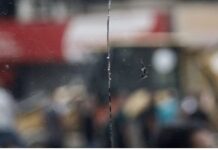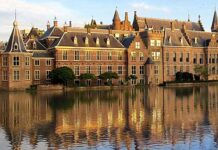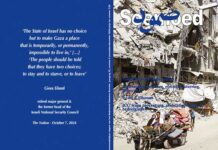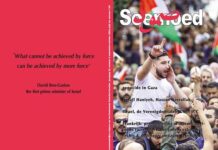Thomas Helm
The National / August 20, 2024
The port city, which Israel holds up as a model of peaceful coexistence [sic], would be a key economic target.
Yona Yahav worked to prevent panic in Haifa during Israel’s 2006 war against Lebanese militant group Hezbollah. Almost 20 years later, and once again the mayor of Israel’s northern port city, he calmly discusses the prospect of a new war.
“We anticipate 4,000 rockets a day,” he says. “What’s different this time is that they are very good ones, unfortunately.”
Now 80, Yahav was in charge of Haifa when Hezbollah’s killing and kidnapping of Israeli soldiers in a cross-border attack led to the month-long conflict in 2006 that Israelis call the Second Lebanon War.
Hostilities broke out between the two once again on October 8 last year, a day after Hamas launched attacks on southern Israel that began the Gaza War, and have only grown more intense since then. Tensions reached a critical level in late July after Israel assassinated senior Hezbollah commander Fouad Shukr in Beirut. Hamas political leader Ismail Haniyeh was killed hours later in Tehran, in an assassination both Hamas and Iran blame on Israel.
Both Hezbollah and Iran have threatened to strike back against Israel, but a renewed push for a ceasefire to end Israel’s devastating military assault on Gaza appears to have put their response on hold.
Yahav tries to stay positive, even though his city is clearly one of Hezbollah’s main targets and a new conflict is likely to be on a much larger scale than in 2006.
“I still don’t think anything will happen,” he says. “All sides will come to an agreement because we have no other choice.
“War is awful. I have been through five wars — it’s enough.”
Haifa has a lot to lose. It is one of Israel’s most economically active cities, with major tech and science sectors, leading universities and an internationally renowned academic hospital. It also has Israel’s main port.
Haifa is also often held up as a model “mixed” city [sic], a term used in Israel to describe places where Arab and Jewish populations live side-by-side. Eleven per cent of the city’s population is Christian and Muslim Arabs, according to official estimate.
At the beginning of the Gaza War in October, there were fears that cities like Haifa might erupt in violence, as was seen during a brief, less intense war between Israel and Hamas in 2021, but things have stayed calm so far.
Yahav describes Haifa as “the only sane city left in the Middle East” and says he is doing all he can to keep it that way despite the pressure of a looming war.
For now, his attempts seem to be working. The drive up to his Art Deco municipal offices goes past vast, glass-fronted campuses, Christian cemeteries and the immaculate Bahai Gardens, a spiritual centre for the Bahai faith. Arab-Israeli workers repair roads in the summer heat.
“In 2006, Haifa had 25 casualties in various areas,” Yahav says. “The main target was the navy base next to Rambam hospital, which was hit as well.”
“There was no panic,” he explains. “The first day, I couldn’t afford for people to panic and leave the city. The war was from the north and the army was coming from the south. If my people ran south it would have made the roads crowded.”
“I decided to bring psychologists and social workers who people could talk to on the phone. It calmed down the whole population. The atmosphere is the same today.
“The people believe in me: I was re-elected a few months ago, unprecedented because I’m 80 years old,” he adds. Yahav was mayor between 2003 and 2018. He was re-elected in 2024.
“Because of what happened in the Second Lebanon War, I believe in the people here.”
But he has also initiated practical steps to help people survive an attack on the city, which Hezbollah has made clear is in its sights. On June 18, the group published a 10-minute video showing drone footage of the Haifa Bay area, including civilian and military ports and the airport.
“You could even see my house,” says Yahav. “Nasrallah says openly that we are the target. I was invited to discussion in parliament after the Second Lebanon War. I said the only person I believe in the Middle East is Nasrallah.”
Yahav’s preparations for war include “building new shelters, filling them up with supplies and training people”.
“Shelters are on one of best inventions of Israelis,” he says.
The National visited an underground emergency call centre and municipal headquarters with room for more than 100 staff. The mayor says that bunkers like this means Haifa can essentially move underground in the event of a war.
“This is led by the municipality. There is no state here and we are not getting help but we can manage. Something happened to people here in 2006. During war everything was working — it was the best of the best, people got united”
The most famous underground facility of all is the $140 million car park at at Rambam hospital. Just 30 per cent of its funding came from the government.
The hospital’s director general Michael Halberthal oversees the facility, which was completed in 2014 after lessons learned in the 2006 war.
“Seventy missiles fell around us during those 34 days of war. There was no Iron Dome [air defence system] back then, so the hospital building was shaking. At the end of the war, the hospital management made the decision this could not happen again,” he says.
Staff can clear the car park of vehicles, clean it and bring in equipment and patients within 72 hours. It is the largest facility of its kind in the world and has all requirements of a typical tier one trauma centre, including 24 operating rooms.
With some of the floors already converted after October 7, Halberthal says it would take just eight hours to transfer all operations underground. It can be self-sufficient for as long as four days.
Beds line the bays beneath massive air conditioning systems. Trolleys full of medical supplies are stacked everywhere. The wards are silent and empty now, but could thousands of people.
“In full capacity we can have about 8,000 people underground. 2,200 patients and then staff and families. We even have a daycare centre for children of staff, which can have as many as 500.
“In case we need to, we can close all doors and be totally self-sufficient for three to four days with no help from the outside.”
Like the mayor, Halberthal manages to stay positive.
“Many things are unique to this city and hospital, one key thing being our pluralism. About 30 per cent of the staff are non-Jews: Arabs, Muslims, Christians, Druze and all the rest. We work together with one mission: to save patients. We have never ever had a problem.”
Thomas Helm is Jerusalem Correspondent at The National












